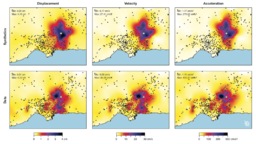Difference between revisions of "High-F Project"
| Line 1: | Line 1: | ||
The SCEC High Frequency (or “High-F”) project will integrate various scientific modeling and simulation efforts within the Southern California Earthquake Center (SCEC) with the objective of reproducing earthquake physics and effects at high frequencies (up to 10 Hz) using deterministic modeling approaches. The High-F project will use current forward wave-propagation simulation capabilities as a point of departure for improving current simulation methods and developing new modeling approaches in order to better reproduce the ground response at higher frequencies. The High-F project will incorporate high-frequency characteristics in the source representation and the structural heterogeneity of the seismic velocity models by considering aspects such as geometrical complexity of the faults, the random distributions of slip, rupture velocity, and rise time, and the stochastic characteristics of the material properties of near-surface layers. One, or more, historic earthquakes in Southern California will be selected as target events, and the results of high-frequency ground motion simulations will be compared with observed data from these earthquakes. The High-F project will help to define a reference framework for the evaluation of alternative simulation methods, such as the stochastic simulation methods developed within the SCEC Broadband Platform, and will seek to identify the threshold frequency at which deterministic and stochastic methods provide a viable tradeoff for hybrid approaches. | The SCEC High Frequency (or “High-F”) project will integrate various scientific modeling and simulation efforts within the Southern California Earthquake Center (SCEC) with the objective of reproducing earthquake physics and effects at high frequencies (up to 10 Hz) using deterministic modeling approaches. The High-F project will use current forward wave-propagation simulation capabilities as a point of departure for improving current simulation methods and developing new modeling approaches in order to better reproduce the ground response at higher frequencies. The High-F project will incorporate high-frequency characteristics in the source representation and the structural heterogeneity of the seismic velocity models by considering aspects such as geometrical complexity of the faults, the random distributions of slip, rupture velocity, and rise time, and the stochastic characteristics of the material properties of near-surface layers. One, or more, historic earthquakes in Southern California will be selected as target events, and the results of high-frequency ground motion simulations will be compared with observed data from these earthquakes. The High-F project will help to define a reference framework for the evaluation of alternative simulation methods, such as the stochastic simulation methods developed within the SCEC Broadband Platform, and will seek to identify the threshold frequency at which deterministic and stochastic methods provide a viable tradeoff for hybrid approaches. | ||
| + | [[Image:Chino_Hills_4Hz.png|256px|thumb|right|Fig 1:Chino Hills earthquake simulation at 4Hz with min Vs=200m/s showing PGA, PGV, and PGD for observed data at ~330 stations compared to simulated ground motions using CVM-S. (Image Credit: J. Bielak/R.Taborda) ]] | ||
== High-F Planning Document == | == High-F Planning Document == | ||
*[http://hypocenter.usc.edu/research/High-F/High-F_Project_Plan_6Sept2012.docx High-F Project Plan] (*.docx format) | *[http://hypocenter.usc.edu/research/High-F/High-F_Project_Plan_6Sept2012.docx High-F Project Plan] (*.docx format) | ||
Revision as of 22:40, 7 September 2012
The SCEC High Frequency (or “High-F”) project will integrate various scientific modeling and simulation efforts within the Southern California Earthquake Center (SCEC) with the objective of reproducing earthquake physics and effects at high frequencies (up to 10 Hz) using deterministic modeling approaches. The High-F project will use current forward wave-propagation simulation capabilities as a point of departure for improving current simulation methods and developing new modeling approaches in order to better reproduce the ground response at higher frequencies. The High-F project will incorporate high-frequency characteristics in the source representation and the structural heterogeneity of the seismic velocity models by considering aspects such as geometrical complexity of the faults, the random distributions of slip, rupture velocity, and rise time, and the stochastic characteristics of the material properties of near-surface layers. One, or more, historic earthquakes in Southern California will be selected as target events, and the results of high-frequency ground motion simulations will be compared with observed data from these earthquakes. The High-F project will help to define a reference framework for the evaluation of alternative simulation methods, such as the stochastic simulation methods developed within the SCEC Broadband Platform, and will seek to identify the threshold frequency at which deterministic and stochastic methods provide a viable tradeoff for hybrid approaches.
High-F Planning Document
- High-F Project Plan (*.docx format)
